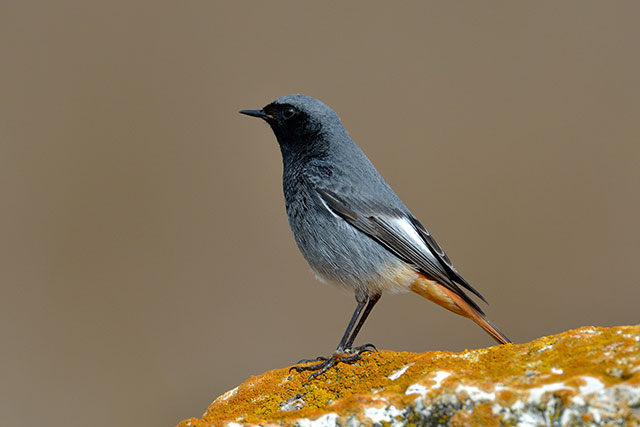Black Redstart (Phoenicurus ochruros) breeds throughout temperate Eurasia and migrates south across its range during winter.
In the western parts of its range, European breeding Black Redstarts migrate to southern Europe, North Africa and the Middle East during winter. But almost all Black Redstarts that breed further east in Central Asia, the Himalaya and East Asia winter in the Indian subcontinent, mainly in central and northern India.
A general upright stance, and a peculiar quivering motion of its tail makes the Black Redstart stand out. This restless bird frequents backyards and the plains of India, from the end of September through March.
The term ‘Redstart’ has been picked up from the old English term ‘Red’ describing the colour, and ‘steort’ meaning ‘tail’ in the proto-Germanic language, which is assumed to be the ancestral language of the Germanic group of languages.
The small robin-sized bird (14-15 cm) breeds across the Himalayan Range. It occurs almost throughout Europe and Asia and in portions of Africa and breed in the high altitude areas of Kashmir, Ladakh, Tibet and the Central Himalayan Range. In their breeding range, the bird is observed to be quite shy and elusive in nature whereas it sees a complete change in character by being one of the most pleasant and friendly of our garden birds during their winter stay here in the city.
In India, the bird essentially sticks to areas near wetlands, open cultivation, scrubs and pleasant gardens and orchards. It savours worms, insects like grasshoppers, or fallen fruits with a curious croaking, a short tsip, tucc-tucc every now and then. While it mostly forages on the ground for grub, it may also catch insects in flight at times.

The males display black or dark-grey upper parts, black breast, and rufous underparts. The females and younger first-year males however, are almost entirely dusky-brown with rufous-orange wash on their lower flanks and belly. Two races of these birds P. phoenicuroides (in Western Himalayas) and P. Rufiventris (in Central and Eastern Himalayas), both come to Delhi in the winters. The primary difference between the two races is that the male of the former has a grey crown, nape, and lower back while these are much darker in the latter.
The bird has a black bill (beak) and legs and the eye colour is mostly dark brown, when seen in good light, else appear dark.
Both sexes display a bright rufous-orange tail that is best seen in flight or when they flash it open while shivering (tail movement) when perched. They do this most often after relishing a meal from the vicinity.
After this month, the bird will return to its preferred breeding grounds. During its stay here, it is generally spread throughout the country, even till the extreme south of the peninsula, frequenting groves of trees, orchards, gardens, and the vicinity of old buildings like the Humayun’s Tomb and Hauz Khas in the capital.
The males pair-up and rear their young with females, thereby protecting their partners and offspring against other males. It is not uncommon for these males to also mate with other females in the area. If you’re sitting still somewhere, keep an eye out on low branches serve as perches for the Black Redstarts. They tend to have preferred perches they return to, unless disturbed.


